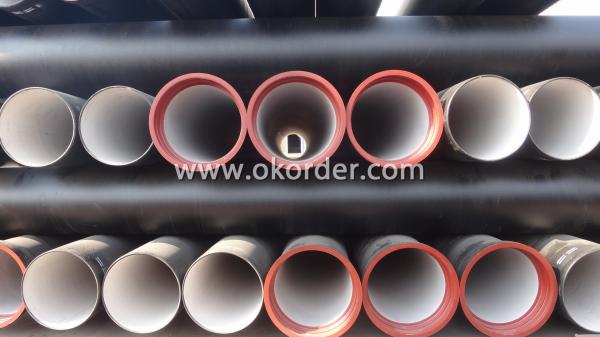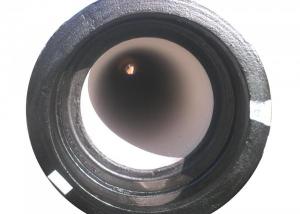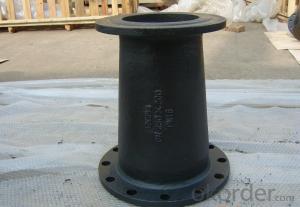Push-on Joint T Type Ductile Iron Pipe Class C
- Loading Port:
- China Main Port
- Payment Terms:
- TT or LC
- Min Order Qty:
- 1 Metric Ton m.t.
- Supply Capability:
- 300000 Metric Tons per Year m.t./month
OKorder Service Pledge
OKorder Financial Service
You Might Also Like
General introduction of Push-on Joint T Type Ductile Iron Pipe Class C
•Material: Ductile Cast Iron
•Size Range: DN 80mm to DN 2000mm
•Unit Effective Length: 5.7m or 6m or negotiable
•Manufacture Standard: ISO 2531:1998/ EN 545:2006/EN 598:2007
•Annual capacity: 300,000 tons
• Internal lining: cement mortar lining comply with ISO4179.
External coating: sprayed metallic Zinc coating (min.130g/m2) according to ISO8179 + bitumen painting (min.70μm) according to BS3416.
Gasket: Matched 100% natural rubber gasket in accordance with ISO4633.
•Special requirements on external coating and internal lining can be applied
•We also provide accessories such as SBR/EPDM rubber gaskets, lubricant paste, pipe caps, PE sleeves, etc.
Features of Ductile Iron Pipes:
Ductile cast iron, also called ductile iron, spheroidal graphite iron, or nodular cast iron, is a type of cast iron invented in 1943. While most varieties of cast iron are brittle, ductile cast iron is much more flexible and elastic, due to its nodular graphite inclusions.
· Ductile Iron Pipe offers proven reliability and the quality.
· It is quick and easy installation.
· The ductile iron pipe has high pressure capability.
· Available in sizes DN80 – DN2000
· Both T Type (Push-on Joint) and K Type (Mechanical Joint) are available
· Match 100% Natural rubber / SBR / EPDM rubber gaskets
Application:
Much of the production of ductile iron is in the form of ductile cast iron pipe, used for water supply and sewerage design. Ductile iron pipe is stronger and easier to tap, requires less support and provides greater flow area compared with pipes made from other materials like PVC, concrete, polyethylene or steel.
Specification of Push-on Joint T Type Ductile Iron Pipe Class C:
Standard wall thickness of Push-on Joint T Type Ductile Iron Pipe Class C
Nominal wall thickness of pipes: e=K (0.5+0.001*DN)
Where, DN: Nominal diameter; K: Coefficient (K=7, 8, 9, 10, 11, 12)
Nominal wall thickness of pipe fittings: e=7+0.014*DN (K=14) e=6+0.012*DN (K=12)
|
Nominal Diameter |
Wall Thickness(mm) | ||||||
|
DN(mm) |
Pipe |
Fittings | |||||
|
Class C |
K8 |
K9 |
K10 |
K12 |
K12 |
K14 | |
|
80 |
4.4 |
6 |
6.0 |
7 |
8.1 | ||
|
100 |
4.4 |
6.0 |
7.2 |
8.4 | |||
|
125 |
4.5 |
6.3 |
7.5 |
8.8 | |||
|
150 |
4.5 |
6.3 |
7.8 |
9.1 | |||
|
200 |
4.7 |
6.3 |
8.4 |
9.8 | |||
|
250 |
5.5 |
6.8 |
7.5 |
9 |
9 |
10.5 | |
|
300 |
6.2 |
6.4 |
7.2 |
8 |
9.6 |
9.6 |
11.2 |
|
350 |
6.3 |
6.8 |
7.7 |
8.5 |
10.2 |
10.2 |
11.9 |
|
400 |
6.5 |
7.2 |
8.1 |
9 |
10.8 |
10.8 |
12.6 |
|
450 |
6.9 |
7.6 |
8.6 |
9.5 |
11.4 |
11.4 |
13.3 |
|
500 |
7.5 |
8 |
9 |
10 |
12 |
12 |
14 |
|
600 |
8.7 |
8.8 |
9.9 |
11 |
13.2 |
13.2 |
15.4 |
|
700 |
8.6 |
9.6 |
10.8 |
12 |
14.4 |
14.4 |
16.8 |
|
800 |
9.6 |
10.4 |
11.7 |
13 |
15.6 |
15.6 |
18.2 |
|
900 |
11.6 |
11.2 |
12.6 |
14 |
16.8 |
16.8 |
19.6 |
|
1000 |
12.6 |
12 |
13.5 |
15 |
18 |
18 |
21 |
|
1200 |
13.6 |
13.6 |
15.3 |
17 |
20.4 |
20.4 |
22.8 |
|
1400 |
15.7 |
15.2 |
17.1 |
19 |
22.8 |
22.8 |
26.6 |
|
1500 |
16.7 |
16 |
18 |
20 |
24 |
24 |
31 |
|
1600 |
17.7 |
16.8 |
18.9 |
21 |
25.2 |
25.2 |
29.4 |
|
1800 |
19.7 |
18.4 |
20.7 |
23 |
27.6 |
27.6 |
32.2 |
|
2000 |
21.8 |
20 |
22.5 |
25 |
30 |
30 |
35 |
Push on Joint T type Ductile Iron Pipe Class C(ISO2531:2009)
Dimensions of preferred class
|
DN(mm) |
DE(mm) |
Wall thickness (mm) |
Approximate Weight of Socket (kg) |
Weight of Straight Section(kg/m) |
Weight of Each Unit(kg/6m) |
Class |
|
Nominal Diameter |
Outside Diameter | |||||
|
80 |
98 |
4.4 |
3.4 |
9.1 |
59 |
C40 |
|
100 |
118 |
4.4 |
4.3 |
11.1 |
71 |
C40 |
|
125 |
144 |
4.5 |
5.7 |
14.1 |
90 |
C40 |
|
150 |
170 |
4.5 |
7.1 |
2.5 |
106 |
C40 |
|
200 |
222 |
4.7 |
10.3 |
22.6 |
145 |
C40 |
|
250 |
274 |
5.5 |
14.2 |
32.6 |
211 |
C40 |
|
300 |
326 |
6.2 |
18.6 |
43.9 |
282 |
C40 |
|
350 |
378 |
6.3 |
23.7 |
51.9 |
335 |
C30 |
|
400 |
429 |
6.5 |
29.3 |
60.8 |
395 |
C30 |
|
450 |
480 |
6.9 |
38.3 |
72.3 |
476 |
C30 |
|
500 |
532 |
7.5 |
42.8 |
87.0 |
566 |
C30 |
|
600 |
635 |
8.7 |
59.3 |
120.6 |
784 |
C30 |
|
700 |
738 |
8.6 |
79.1 |
142.0 |
932 |
C25 |
|
800 |
842 |
9.6 |
102.6 |
176.9 |
1165 |
C25 |
|
900 |
945 |
10.6 |
129.0 |
215.5 |
1422 |
C25 |
|
1000 |
1048 |
11.6 |
161.3 |
262.1 |
1759 |
C25 |
|
1100 |
1152 |
12.6 |
194.7 |
313.55 |
2103 |
C25 |
Photo show of Push on Joint T type Ductile Iron Pipe Class C


- Q:What are the advantages of using ductile iron pipe over HDPE pipe?
- Ductile iron pipe offers numerous benefits compared to HDPE pipe. Firstly, it is renowned for its exceptional strength and durability. With the ability to withstand higher pressure, it is less prone to leakage or bursting, making it an ideal choice for applications requiring high-pressure water or gas transmission, such as municipal water supply systems or industrial piping networks. Secondly, ductile iron pipe boasts an extended lifespan when compared to HDPE pipe. Its remarkable resistance to corrosion allows it to endure for decades, even in harsh environmental conditions. As a result, frequent replacements are minimized, leading to long-term cost savings. Furthermore, ductile iron pipe exhibits excellent fire resistance properties. It can endure high temperatures without compromising its structural integrity, making it a reliable option for applications where fire safety is a concern, such as fire hydrant systems or sprinkler systems. Additionally, ductile iron pipe is renowned for its superior flow characteristics. Its smooth inner surface reduces friction loss, facilitating efficient and consistent fluid flow. This attribute is particularly crucial in applications that necessitate maximum flow capacity, such as water distribution systems or wastewater treatment plants. Moreover, ductile iron pipe is highly recyclable, promoting environmental sustainability. It can be melted down and utilized to manufacture new pipes, thereby reducing its environmental impact. In conclusion, ductile iron pipe offers a multitude of advantages over HDPE pipe, including its exceptional strength and durability, prolonged lifespan, fire resistance, superior flow characteristics, and recyclability. These features establish ductile iron pipe as the preferred choice for various applications, particularly those that require high-pressure transmission, longevity, fire safety, efficient flow, and environmental sustainability.
- Q:What is the expected hydraulic efficiency of ductile iron pipes?
- The expected hydraulic efficiency of ductile iron pipes can vary depending on several factors including pipe diameter, roughness of the pipe surface, flow rate, and length of the pipe. However, ductile iron pipes are generally known to have excellent hydraulic efficiency. Ductile iron pipes have a smooth inner surface, which reduces frictional losses and allows for efficient water flow. The smoothness of the pipe surface helps minimize energy losses due to turbulence and resistance. Additionally, ductile iron pipes are designed to have a consistent and uniform internal diameter, which further enhances their hydraulic efficiency. Studies have shown that ductile iron pipes can achieve hydraulic efficiencies ranging from 85% to 95%. This means that a significant portion of the energy put into the system is effectively transferred to the water, resulting in minimal losses. It is important to note that the hydraulic efficiency of ductile iron pipes can be influenced by factors such as corrosion, scaling, and sediment buildup over time. Regular maintenance and proper cleaning can help maintain the hydraulic efficiency of ductile iron pipes. Overall, ductile iron pipes are considered to be highly efficient in terms of hydraulic performance and are widely used in water distribution systems due to their ability to deliver water with minimal energy losses.
- Q:How does ductile iron pipe compare to PVC pipe in terms of performance and cost?
- Ductile iron pipe and PVC pipe have different characteristics in terms of performance and cost. Ductile iron pipe is known for its strength, durability, and ability to withstand high pressure and heavy loads, making it ideal for applications that require robust performance such as water distribution systems. On the other hand, PVC pipe is lightweight, corrosion-resistant, and more flexible, making it suitable for above-ground and non-pressurized applications like drainage systems. In terms of cost, PVC pipe is generally less expensive than ductile iron pipe, especially for smaller diameter pipes. However, as the diameter increases, ductile iron pipe becomes more cost-effective due to its superior strength and longer lifespan, which reduces maintenance and replacement costs over time. Ultimately, the choice between ductile iron and PVC pipe depends on the specific application, budget, and desired performance characteristics.
- Q:What are the different joint types available for ductile iron pipe?
- Ductile iron pipes offer a range of joint types, each with its own benefits and uses. The most commonly employed joint types in ductile iron pipe installations include: 1. Push-on Joint: This type involves inserting a rubber gasket into a groove on the pipe's spigot end. The pipe is then pushed into the bell end of the adjacent pipe, creating a watertight seal. Push-on joints are known for their quick and easy installation, making them perfect for applications that require efficiency. 2. Mechanical Joint: This joint relies on a gland and follower gasket, which are compressed between the spigot end of one pipe and the bell end of another. Bolts and nuts are used to secure the joint, ensuring a tight and secure connection. Mechanical joints provide excellent integrity and are used in applications with higher pressures or heavy loads. 3. Flanged Joint: Flanged joints utilize flanges on the pipe ends, which are bolted together with gaskets to achieve a leak-proof connection. These joints are commonly employed in situations where pipes need to be easily disconnected and reconnected, such as pump stations or valve connections. 4. Restrained Joint: These joints are specifically designed to prevent pipes from separating under high internal pressures or external forces. They typically incorporate mechanical joints with additional restraining devices like harnesses, rods, or thrust blocks. Restrained joints are commonly used in applications where pipe movement poses a risk or stability is crucial. It is important to consider factors like the application, operating conditions, and project requirements when selecting a joint type. Consulting a professional engineer or pipe manufacturer is advisable to ensure the most suitable joint type is chosen for a specific ductile iron pipe installation.
- Q:Can ductile iron pipes be used for trenchless installations?
- Yes, ductile iron pipes can be used for trenchless installations. Trenchless technology allows for the installation, repair, or replacement of underground infrastructure without the need for extensive excavation. Ductile iron pipes, known for their strength and durability, are suitable for various trenchless methods such as horizontal directional drilling (HDD), pipe bursting, and slip lining. These methods minimize disruption to the surrounding environment and reduce costs compared to traditional open-cut trenching.
- Q:How do ductile iron pipes handle soil movement?
- Ductile iron pipes are known for their excellent strength and durability, making them highly capable of handling soil movement. These pipes are designed to resist external loads and pressures caused by soil settlement, ground shifting, or other environmental factors. One of the key features of ductile iron pipes is their flexibility. Unlike rigid materials such as cast iron or concrete pipes, ductile iron pipes have a certain level of elasticity that allows them to withstand soil movement without cracking or breaking. This flexibility enables the pipes to absorb the stresses induced by the soil, preventing any significant damage to the pipeline system. Furthermore, ductile iron pipes possess high tensile strength, which means they can resist pulling forces resulting from soil movement. The pipes can withstand the expansion and contraction of the surrounding soil, reducing the risk of pipe deformation or failure. Moreover, ductile iron pipes are often installed with proper bedding and backfilling techniques to further enhance their ability to handle soil movement. Adequate bedding materials, such as crushed stone or sand, are used to provide stable support to the pipes and distribute the external loads evenly. This helps to minimize the impact of soil movement on the pipes and maintain their structural integrity. In summary, ductile iron pipes are designed to effectively handle soil movement due to their flexibility, high tensile strength, and proper installation methods. These pipes can withstand the stresses induced by soil settlement, ground shifting, or other soil-related factors, ensuring reliable and long-lasting performance in various environmental conditions.
- Q:Do ductile iron pipes require internal linings for potable water?
- No, ductile iron pipes do not require internal linings for potable water. Ductile iron is a type of iron that has been treated to enhance its strength and flexibility. It is commonly used for water distribution systems due to its durability and resistance to corrosion. Unlike other materials, such as cast iron or steel, ductile iron pipes have a protective layer called a cement-mortar lining, which provides an effective barrier against corrosion and prevents the leaching of any harmful substances into the water. This lining is applied during the manufacturing process and is designed to withstand the corrosive properties of potable water, making internal linings unnecessary. Additionally, the smooth surface of ductile iron pipes helps to maintain the quality and flow of water without the need for additional linings.
- Q:Can ductile iron pipe be used for hydropower systems?
- Ductile iron pipe is perfectly suitable for hydropower systems. It is renowned for its robustness, longevity, and ability to resist corrosion, making it an excellent option for numerous applications, including hydropower systems. The remarkable tensile strength of ductile iron enables it to endure the immense pressure and heavy loads associated with such systems. Additionally, its resistance to corrosion makes it ideal for use in water environments, ensuring a lengthy lifespan and minimal maintenance requirements. Consequently, ductile iron pipe can effectively serve hydropower systems by offering a dependable and efficient solution for water transportation and infrastructure support.
- Q:How can the cast iron pipe be connected?
- Cast iron pipes are flanged and socket connected
- Q:Can ductile iron pipes be repaired if they get damaged?
- If ductile iron pipes sustain damage, it is indeed possible to repair them. To carry out the repair, the first step involves identifying the specific section of the pipe that has been damaged, followed by assessing the extent of the damage. In the case of minor damage, there are several techniques available for repair, including welding or applying epoxy lining. However, if the damage is more severe, it may be necessary to replace certain sections of the pipe. Professionals who specialize in pipe repair possess the necessary skills and equipment to accurately identify and effectively fix damaged ductile iron pipes, thereby guaranteeing their ongoing functionality and durability.
1. Manufacturer Overview |
|
|---|---|
| Location | Henan, China |
| Year Established | 1958 |
| Annual Output Value | Below US$1 Million |
| Main Markets | Mid East, Africa, South Asia, Eastern Asia |
| Company Certifications | ISO 9001:2008;ISO2531:2000 |
2. Manufacturer Certificates |
|
|---|---|
| a) Certification Name | |
| Range | |
| Reference | |
| Validity Period | |
3. Manufacturer Capability |
|
|---|---|
| a)Trade Capacity | |
| Nearest Port | Tianjin; Qingdao |
| Export Percentage | 1% - 10% |
| No.of Employees in Trade Department | 3000 People |
| Language Spoken: | English; Chinese; Spain; Alabic |
| b)Factory Information | |
| Factory Size: | Above 150,000 square meters |
| No. of Production Lines | Above 6 |
| Contract Manufacturing | OEM Service Offered; Design Service Offered |
| Product Price Range | Average |
Send your message to us
Push-on Joint T Type Ductile Iron Pipe Class C
- Loading Port:
- China Main Port
- Payment Terms:
- TT or LC
- Min Order Qty:
- 1 Metric Ton m.t.
- Supply Capability:
- 300000 Metric Tons per Year m.t./month
OKorder Service Pledge
OKorder Financial Service
Similar products
New products
Hot products
Hot Searches
Related keywords




























